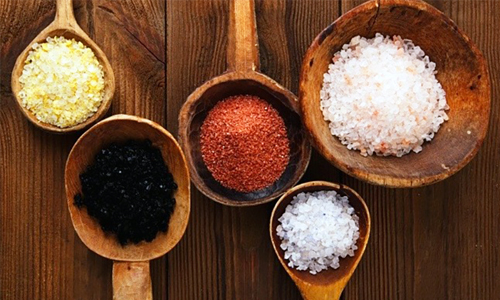

Salts have exploded with popularity. What once was a simple decision between iodized table salt or sea salt has become a sensory overload. Walk into Whole Foods to restock on salt and you’ll be confronted with a dazzling array of colors, textures and price points. But, what really differentiates specialty salts? Are expensive salts actually worth the money?
Here is a guide to nine different culinary salts that will help you decide what salt is best for your needs.
1. Table
Table salt is created by superheating natural salt to 1,200 degrees Fahrenheit, which destroys most beneficial compounds. Fortified with essential iodine, table salt is also bleached and devoid of trace elements, so it’s certainly not the healthiest salt you can shake. This type of salt can often contains additives to slow moisture absorption so it is easy to sprinkle in your salt shaker.
Some experts claim that this highly refined version of salt is responsible for many sodium-related health issues, whereas unrefined salts heal the body instead of harming it.
2. Sea
Most people are very familiar with sea salt. This salt comes from—you guessed it—the ocean and undergoes an evaporation process to separate the salt from the water. Sea salt contains a small amount of natural iodine, although not nearly as much as iodized salt. It is typically much less refined than table salt and comes in both fine and coarse varieties.
While sea salts are a great unrefined choice, unfortunately, pollution is steadily becoming a concern. Whereas ancient seas were once clean, we have sullied our ocean coastlines with pollutants like microplastics. While this is no means a reason to give up sea salt—microplastics have infiltrated nearly everything—it’s good to keep yourself in the know and balance your sea salt consumption with other, earth-bound salts.
3. Himalayan Pink
These salts come from ancient seabeds in the Himalayan mountains. Their pink color comes from their rich iron content. This salt is, in fact, quite rich in minerals, containing all 84 essential trace elements required by your body. Pink salt can assist in many bodily functions, such as reducing muscle cramps, promoting blood sugar health and promoting healthy pH in your cells.
Many experts recommend pink salt as one of the healthiest salts you can consume. Its popularity has made it more affordable than other more exotic salts on the market.
4. Grey
Colored by the clay from where it’s harvested, grey salt is often called Celtic Sea Salt. It is hand-raked in Brittany, France, where the natural clay and sand create moist, mineral-rich crystals. This salt generally retains its moistness.
Grey salt can help to restore electrolyte balance, has alkalizing properties and can prevent muscle cramps, much like pink salt. However, this salt is a bit more expensive, due to the labor intensive process of hand-raking.
5. Fleur de sel
Meant to be used as a finishing salt, this “flower of the salt” usually has a hefty price tag. It is hand-harvested along the French coastline in the same pools as grey salt.
However, for every 40 kilograms of grey salt produced, only 1 1/2 kilograms of delicate fleur de sel is harvested. This light and flaky salt is highly prized and generally used for finishing foods. In terms of health, it’s simply a pricey mineral-rich sea salt with a delicate flavor and texture.
6. Black
Originating from Hawaii, black lava salt is unrefined and volcanic. Its black color is due to its content of activated charcoal, which is great for digestion and removing impurities in the body.
The contrast of color can also make dishes more visually interesting. There is also another black salt, kala namak, which originates from India and is actually pink once it’s ground. It is highly sulphuric in taste and content. For this reason, it is thought to be a beneficial digestive aid. Both black salts are highly prized and can be healthful when used on occasion.
7. Red
Another Hawaiian salt, red salt gets its color from the volcanic Hawaiian clay called alaea. As water evaporates, this salt gets trapped in tidal pools, where it mixes with the alaea.
It is estimated to contain the highest concentration of essential trace minerals of any salt and is especially iron rich. If you have a tendency to be low in iron, this salt may be a good addition to your balanced diet.
8. Persian Blue
This unique salt harvested from an ancient salt lake in Iran is extremely mineral rich and slightly sweet. Its blue color comes not from mineral content, but from the natural compression of the salt’s structure over the millennia. The same beautiful effect is seen in blue glacial ice, where the molecular structure has been compressed to the point that it begins to refract light differently.
While aesthetically exciting, as one of the rarest salts in the world, this salt may not be worth the price tag if you’re just shopping for health benefits.
9. Smoked
Smoked salts have no significant nutritional benefits over normal sea salt. In fact, they are simply sea salts smoked at low temperatures over a bed of coals, which lends a lovely smokey flavor to the crystals and a grey or tan color. The smokey flavor lends dimension to certain dishes, but they have no health benefits beyond those associated with regular sea salt.
When it comes to choosing a healthy salt, don’t get confused by price. In general, it’s better to consume unrefined salt over table salt, since it’s generally lower in sodium and high in essential minerals. Other than that, you don’t need to spend a fortune to consume healthy salt. Exotic salts can make for a lovely culinary experience, but in terms of health, no single unrefined salt is undeniably better than another. Choose a salt that suits your needs and enjoy it in combination with a smart, healthy lifestyle.

 233k
233k  41k
41k  Subscribe
Subscribe 